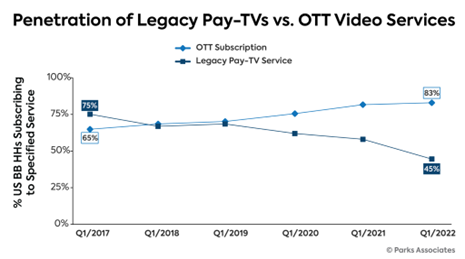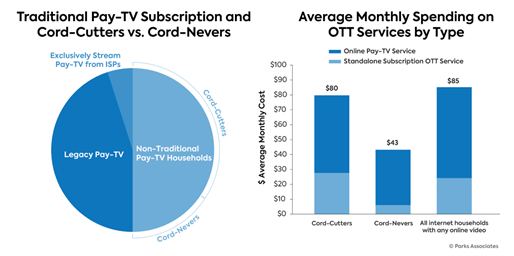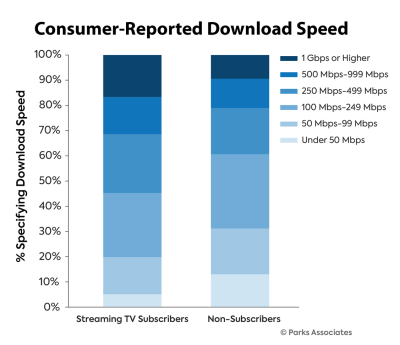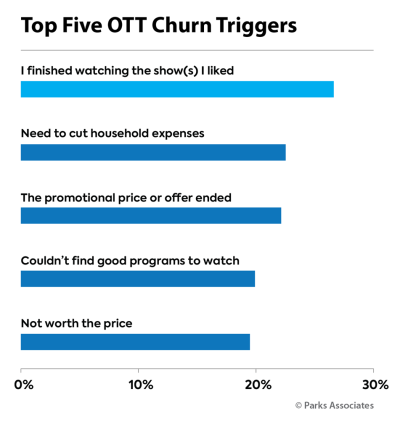How consumers watch video has dramatically changed in the past five years.
Currently, 83% of US internet households subscribe to at least one streaming video service. In contrast, only 45% subscribe to traditional pay-TV services like AT&T or Comcast — a dramatic drop from almost 10 years ago in 2012 when this figure was at 87%. However, this is not the end of linear programming, as nearly half of households still hold on to a traditional linear model. Instead, this 45% emphasizes how almost half of households still value this form of content delivery.

Whether for traditional pay-TV services or streaming video services, there is pressure to drive retention and growth in an increasingly churn-prone consumer environment. Strong viewer data now play a critical role in whether new services succeed in this hyper-competitive video service market.
The most successful of the next generation of video services will be dominated by innovative technologies, including AI and ML, that drive sustained high levels of engagement with consumers through advanced content moderation and curation, thus increasing advertising effectiveness, as well as customer retention (i.e., reducing churn) and satisfaction (e.g., NPS).
Artificial Intelligence (AI) is the capability of computer systems to simulate human intelligence processes on a large scale. AI algorithms are trained to employ human-like intelligence in analyzing and solving complex business problems in a fast, efficient, and automated way.
Machine Learning (ML) is the ability of an AI system to autonomously learn from its data and improve its own algorithms.
- Supervised ML: The AI system learns from human input by being trained on existing data. The AI develops its model based on its ability to accurately match correlations, predictions, and other analytical functions within sample data sets.
- Unsupervised ML: AI is not limited to the factors currently known by humans. Instead, the AI learns autonomously and detects anomalies and correlations that have yet to be identified, even across large, heterogeneous data sets.
The research firm reports that “cord-cutters,” or consumers who have terminated traditional pay-TV services, make up around 37% of all US internet households. Additionally, they reflect the rising consumer interest in streaming video services. Cord-cutter spending is about 6% less than the overall OTT subscriber population and 32% less than what consumers were paying in a traditional pay-TV agreement.
On average, cord-cutters spend about $80 per month on OTT services.

AVOD services (e.g., Crackle Plus) include a library of on-demand content that viewers can access at any time with ad breaks built in. Free Ad-Supported Television (FAST) services (e.g., Pluto TV) are more similar to linear TV as viewers can choose among a variety of channels with scheduled programming and commercial breaks. Both services are free to users.
Ad-based services are becoming more popular among consumers increasingly fatigued by the plethora of options, associated costs, and pressure to choose that accompanies a subscription video-on-demand (SVOD) service. Today, 33% of US internet households watch ad-based OTT services, possibly because FAST services in particular offer a no-cost “lean back” experience where choosing content is simplified to selecting a channel rather than a particular program. As budgets tighten, even more consumers may gravitate towards these ad-based services.
Providers then have an opportunity to partner with advertising companies to design tailored content and marketing campaigns based on specific interests and behaviors derived from data.
Some examples of recent unique ad-based partnerships:
- VIDAA and Amagi announced a partnership to expand FAST services globally.
- AVOD service Crackle Plus partnered with PetSmart to deliver Pet Caves, a pet-centric home improvement series.
- A + E partnered with Opendoor to create Move or Improve, a show about the decision to sell or remodel.
Companies benefit from new partnerships through increased brand awareness, expansion into new markets, and enhanced value for their products and services (e.g., “The Disney Bundle” — Hulu, Disney+, ESPN+). The Disney package is a content bundle built to appeal to multiple audience segments. Through its mix of content for sports fans, die-hard Disney fans, and entertainment enthusiasts, Disney is boosting viewership across all of its streaming properties while consumers gain a simplified budget and content discovery experience.
Partnerships among various industry players can increase revenues while still providing a way for consumers to customize their service stacks. Then, leveraging newly available data to refine AI recommendation engines can further improve the customer experience and result in a “stickier” customer. These partnerships are not exclusive to OTT service providers. Internet service providers (ISPs) are also offering their own bundles as consumer need for higher broadband speeds rises alongside OTT subscriptions.

Parks Associates' research reveals that the top three reasons consumers chose an OTT service were related to the availability of content — namely specific titles, genres, and the availability of original programming. Conversely, changes in an OTT service user’s activity, whether sudden or gradual, can be an indicator of dissatisfaction and future churn behavior. The top reasons include having finished a series, budgetary concerns, and an absence of appealing content.
Streaming services can capture and analyze data relating to users’ viewing habits for the creation of data-based retention efforts targeted toward churn-prone users. There is also an opportunity to use this data for recapturing users who have already canceled their OTT service by promoting content related to past viewing habits. AI-enabled solutions can proactively detect behaviors indicative of churn as well as identify appropriate retention measures.

Download Parks Associates' complimentary whitepaper “Engaging Next-Gen Video Viewers: Leveraging AI and ML,” in collaboration with FPT Software for insights on how businesses can leverage data supplied into artificial intelligence (AI) and machine learning (ML) models to drive personalization, automation, and more. It also discusses the increased use of video services, content preferences, discovery challenges, and the role of bundles. This whitepaper addresses the increased consumer use of video services and content preferences, discovery challenges, and the role of bundles in shaping the market now and in the future. It also shows how streaming businesses can use AI and ML to drive engagement and monetization.
Sarah Lee joined Parks Associates as a Research Analyst on the Entertainment side and covers topics such as OTT and consumer electronics.
Sarah earned her PhD in Experimental Psychology from The University of Texas at Arlington. She also earned an MS in General Experimental Psychology from Murray State University and a BS in Psychology from Xavier University.
Tam Williams is a Research analyst at Parks Associates and serves as a resource primarily to the Marketing and Research Teams, contributing to press releases, content marketing, event speaker logistics, marketing research, and many other projects.
With undergraduate and graduate degrees in business and theology, respectively, Tam’s ongoing experience involves freelance writing and editing projects across multiple industries.
Industry Voices are opinion columns written by outside contributors—often industry experts or analysts—who are invited to the conversation by Fierce Video staff. They do not represent the opinions of Fierce Video.